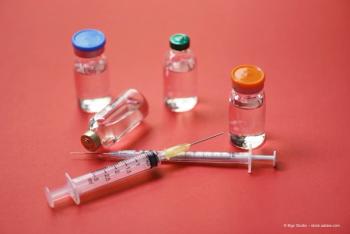
Making strides in uveitis therapy
With advances in local treatment of uveitis over the past decade, the therapeutic armamentarium has increased from depot injections with short-lasting activity to long-term treatments, said Thomas A. Albini, MD. One example of an advanced technology with well-established, long-acting efficacy is the fluocinolone acetonide intravitreal implant 0.59 mg (Retisert, Bausch + Lomb), but it also is associated with risks.
"About 30% to 40% of patients implanted with this device will require glaucoma surgery during the 2 years that the implant is in place, and cataracts will develop in most patients,” said Dr. Albini, associate professor ophthalmology, Bascom Palmer Eye Institute, University of Miami Miller School of Medicine. The 2-year MUST Trial-the largest trial at the time it was performed to study patients with posterior segment non-infectious uveitis-included 479 eyes of patients who were randomly assigned to the device or systemic therapy. The primary endpoint was the final visual acuity; the secondary endpoint was control of inflammation. Data from up to year 7 were available for these patients, he explained.
Analysis of the data after year 7 found that after year 5 the intent-to-treat patients in the systemic arm fared significantly better than those in the implant arm, Dr. Albini recounted.
Up to the 2-year time point, many of the secondary effects favored the implant. However, visual acuity data was a draw, he noted. Kempen et al. published their results in JAMA (2017;317:1993-2005. doi: 10.1001/jama.2017.5103. PubMed PMID: 28477440; PubMed Central PMCID: PMC5540027).
The report suggested that long-term systemic therapy was superior to local therapy, Dr. Albini noted, but this needs to be taken with a grain of salt. He advised that physicians consider the reported data carefully.
In contrast, he noted, a graph in the supplement to the article in JAMA showed that only about 25% of patients in the intend-to-treat implant arm after year 3 actually were implanted with the device within the previous 3 years.
“This may mean they were undertreated; that is, there were no steroids in the eye being released after year 4,” Dr. Albini said. “This might explain the drop-off in both the inflammatory control and visual acuity benefits after year 6.”
Safety data from the systemic arm of the study at year 7 showed that standard systemic therapy, when properly monitored, is “incredibly safe.” No serious systemic safety issues appeared in the patients treated with systemic therapy compared with the control group.
ADVANCES IN IMPLANT TECHNOLOGY
The third generation of the implants (developed by pSivida Corp.) following the development of Vitasert and Retisert is the Durasert device (Iluvien, fluocinolone) developed to treat diabetic macular edema. The device also was evaluated in phase III studies for treating uveitis.
“The trials have very strong data showing the reduced probability of the recurrence of uveitis through day 380 after insertion of one Durasert device,” Dr. Albini noted.
Clearside Biomedical has developed a proprietary microinjector that injects 4 mg of triamcinolone into the suprachoroidal space.
“The drug diffuses throughout the suprachoroidal space and provides two orders of magnitude higher concentration of the drug at the retina and choroid and two orders of magnitude lower concentration of the drug in the lens and trabecular meshwork, which minimizes the side effects and maximizes the drug effect,” he said.
The preliminary phase II data with this device is promising for reducing cystoid macular edema (CME) in patients with uveitic CME. Importantly, short-term IOP values did not increase because of the steroid. Intravitreal sirolimus, a novel immunoregulatory agent, is a local therapy for treating non-infectious uveitis of the posterior segment. The drug works by interrupting the inflammatory cascade and inhibiting Tcell activation, proliferation, and differentiation and increases regulatory T lymphocytes. This formulation forms a depot in the vitreous that slowly diffuses over 2 months with minimal systemic exposure.
The pooled SAKURA study from two studies showed that the injection met its primary endpoint, seems to be safe, and exerts an anti-inflammatory effect without inducing glaucoma and cataract. The drug may be available soon, although it appears the FDA is requiring more data, according to Dr. Albini. Administration of steroids over the long term (more than 3 months) and at doses exceeding 10 mg daily is dangerous. Considering that, methotrexate, mycophenolate, and cyclosporine have been used over the previous decades. Adalimumab is the first FDA-approved systemic agent to be added to the armamentarium.
Two large prospective, multicenter trials have shown the efficacy of the drug for treating active non-infectious uveitis. “There is better ease in monitoring this medication and probably better patient compliance since the drug is administered subcutaneously every 14 days compared with mycophenolate, which is administered twice daily,” Dr. Albini said. “However, no study has compared the relative efficacy or safety of the two drugs.” Anti-interleukin-6 tocilizumab (Actemra, Genentech) appears to be a promising therapy for treating non-infectious uveitis. Dr. Albini described a representative patient treated with infusion of the drug. At baseline, central retinal thickness was 861 μm with vitreous haze and CME. By month 6, central retiretinal thickness decreased to 292 μm with decreased haze and edema. A phase II study of 40 patients showed the same results over time.
Another compound, sarilumab (Kevzara, Regeneron), is also administered by subcutaneous injection. The results in patients were similar to those with tocilizumab with decreased vitreous haze and macular edema. Repository corticotropin injection (Acthar Gel, Mallinckrodt Pharmaceuticals) is an old drug administered subcutaneously or intramuscularly that has not been used to treat uveitis. Safety and efficacy data are missing, but it has been used to treat refractory uveitis.
“New local and systemic therapies are under development for treating uveitis, but steroids remain essential,” Dr. Albini summarized. “Biologics promise safer systemic steroid-sparing options. Unconventional strategies are in the pipeline.”
THOMAS A. ALBINI, MD
E: talbini@med.miami.edu
This article was adapted from Dr. Albini’s presentation during Retina Subspecialty
Day at the 2017 meeting of the American Academy of Ophthalmology.
Dr. Albini is a consultant and advisor for Abbvie, Allergan, Bausch + Lomb, Clearside
Biomedical, Genentech, Mallinckrodt, pSivida, and Santen Inc.
Newsletter
Keep your retina practice on the forefront—subscribe for expert analysis and emerging trends in retinal disease management.








































